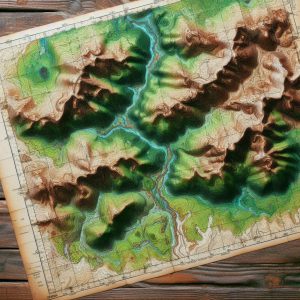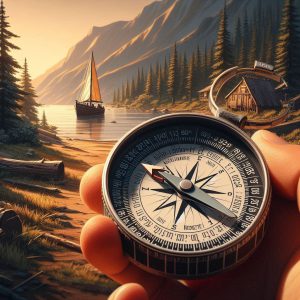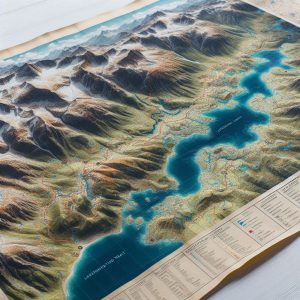Master Essential Wilderness Navigation Skills for Unmatched Outdoor Adventures Without GPS
Learning to navigate the wilderness without modern technology can seem intimidating initially, but developing crucial map and compass navigation skills is a game-changer that significantly enhances your outdoor journey. Mastering navigation is about more than just knowing where you are; it’s about understanding the intricate details of your environment and being able to pinpoint your position relative to your desired destination. A map acts as a comprehensive two-dimensional depiction of the terrain, while a compass is your trustworthy guide, providing orientation based on the cardinal directions: north, south, east, and west. By honing these essential tools, you can explore nature with confidence, liberated from the confines of technological reliance.
Begin your navigation journey by immersing yourself in the various symbols and scales featured on a map; these elements are essential for effectively interpreting the physical world around you. Learning to read contour lines, which indicate changes in elevation, is critical. This knowledge enables you to recognize geographical features like hills and valleys that could affect your chosen route. Additionally, mastering the use of a compass is equally vital, as it equips you with the capability to navigate through the wilderness without needing GPS devices, fostering a deeper connection with nature.
The compass needle consistently points toward magnetic north, which is essential for aligning your map with the actual landscape. To achieve this, hold the compass flat in your hand and turn the map until the magnetic north on the compass matches the north shown on the map. This vital technique, known as “orienting the map,” is crucial for maintaining precision in your navigation efforts, thereby ensuring that you remain on the correct path throughout your journey.
After orienting your map accurately, you can utilize the compass to take bearings that will direct your travel. By effectively combining these two powerful navigational tools—the map and the compass—you can confidently traverse unknown terrains, ensuring you stay on course even in the absence of modern technological aids.
Core Principles for Effective Wilderness Navigation
- Developing skills in map and compass navigation is vital for anyone engaging in outdoor exploration or wilderness activities.
- Topographic maps provide intricate details about the terrain, elevation, and natural features, making them indispensable for successful navigation.
- A compass not only helps establish direction but also works in harmony with the map’s orientation to understand magnetic north effectively.
- Natural landmarks and cues, such as distinct rock formations or unique tree patterns, can serve as excellent navigational aids in the absence of a map or compass.
- Estimating distance and travel time is crucial for planning and executing an effective navigation strategy in wilderness settings.
 Discover the Significance of Topographic Maps in Wilderness Navigation
Discover the Significance of Topographic Maps in Wilderness Navigation
Topographic maps are essential tools for anyone planning to explore the wilderness. They convey a wealth of information about the physical landscape, utilizing contour lines to illustrate changes in elevation. This representation allows you to visualize the terrain’s shape and steepness, aiding you in preparing for the challenges ahead. Each contour line connects areas of equal elevation, and the distance between these lines indicates whether the slope is steep or gradual, providing you with the insights necessary for effective navigation.
Interpreting Contour Lines and Map Symbols for Navigation Success
When examining a topographic map, it is crucial to observe the patterns created by contour lines; closely spaced lines indicate steep terrain, while wider lines signal flatter areas. This knowledge empowers you to anticipate potential challenges along your route, allowing for informed navigation decisions. Additionally, topographic maps are filled with symbols representing various landmarks, including rivers, roads, trails, and types of vegetation. Familiarizing yourself with these symbols is fundamental for successful navigation, ensuring that you can utilize the map effectively and efficiently.
Expert Techniques for Navigating with Topographic Maps
For example, blue lines often signify water bodies like streams or lakes, while green shaded areas may indicate forests or dense vegetation. By cross-referencing these symbols with your immediate surroundings, you can verify your location and adjust your route as necessary. Furthermore, topographic maps usually include grid lines that help you pinpoint coordinates, facilitating even more precise navigation. By mastering the details of topographic maps, you will not only enhance your navigational skills but also develop a greater appreciation for the wilderness around you.
 Enhancing Directional Navigation Skills Using a Compass
Enhancing Directional Navigation Skills Using a Compass
A compass is an invaluable tool for any outdoor enthusiast, particularly for directional navigation in unfamiliar landscapes. To use a compass effectively, start by holding it level in front of you and allowing the needle to stabilize. The needle will point toward magnetic north, which may differ slightly from true north due to magnetic declination—the angle between magnetic north and true north varies depending on your geographical location.
Before you set out on your adventure, it’s crucial to determine the local declination and adjust your compass accordingly. This adjustment helps maintain the accuracy of your bearings, ensuring you stay on course throughout your journey. Once your compass is calibrated for declination, you can proceed to take a bearing that will guide your travel direction effectively.
To take a bearing, identify a landmark you wish to navigate towards and rotate the compass housing until the orienting arrow aligns with the magnetic needle. The degree reading on the compass dial that aligns with the index line indicates your bearing. As you move towards your destination, periodically check your bearing to confirm that you remain on the right track.
If you find yourself drifting off course, reorient your compass and adjust your path as necessary. By mastering these techniques, you will gain the confidence to rely on a compass as a dependable navigational aid in any outdoor adventure, empowering you to explore with assurance.
 Utilizing Natural Landmarks and Cues to Navigate Effectively
Utilizing Natural Landmarks and Cues to Navigate Effectively
While maps and compasses are critical navigational tools, keenly observing natural landmarks and signs can greatly enhance your ability to navigate the wilderness efficiently. Notable features such as mountains, rivers, or distinct tree formations can serve as valuable reference points when traversing unfamiliar terrain. For instance, if you know that a specific mountain lies to the east of your starting position, you can use it as a guide to verify that you are heading in the right direction.
Moreover, familiarizing yourself with the unique characteristics of your surroundings will aid in forming mental maps that allow you to navigate without solely relying on tools. In addition to prominent landmarks, paying attention to natural signs can indicate direction or changes in terrain. The sun’s position can be a helpful guide; in the northern hemisphere, the sun rises in the east and sets in the west, providing a general sense of direction throughout the day.
Additionally, observing moss growth on trees—often denser on the north side—can offer valuable clues about orientation in dense forests. Animal trails can also provide directional hints, as many animals follow established paths that can lead you toward water sources or other significant landmarks. By refining your ability to interpret these natural signs, you will become increasingly adept at navigating diverse environments, enhancing your overall wilderness experience.
Accurate Distance Estimation and Travel Time for Effective Navigation
Estimating distance and travel time is essential for effective navigation in wilderness areas. Knowing how far you have traveled and how long it will take to reach your destination facilitates better planning and helps avoid unforeseen challenges. One practical technique for estimating distance is pacing—counting your steps as you walk.
An average adult’s stride measures approximately 2.5 feet, allowing you to estimate the distance you’ve traveled based on your pace by counting your steps over a known distance. It’s also important to consider the type of terrain and elevation changes when calculating travel time. For instance, moving across flat ground typically allows for quicker travel compared to navigating steep hills or rocky paths, which can significantly slow your progress.
A common guideline suggests that you can cover roughly three miles per hour on flat terrain, but this estimate should be adjusted considerably when faced with challenging conditions. By taking these variables into account and modifying your expectations accordingly, you will be better prepared for your journey and more capable of managing your time effectively in the wilderness.
Creating a Comprehensive Wilderness Route and Navigation Plan
Strategically Mapping Out Your Wilderness Route for Success
Before embarking on any wilderness adventure, crafting an effective navigation plan is crucial. Start by studying topographic maps of the area you intend to explore, identifying potential routes based on visible landmarks, existing trails, and accessible water sources. As you devise your route, consider elevation changes and the difficulty level of the terrain; ensuring your plan is realistic and achievable is essential for a successful journey.
Preparing for Unexpected Obstacles and Navigational Changes
While planning your route, it’s wise to consider alternative paths in case you encounter unexpected obstacles or sudden weather changes. Having multiple options will grant you greater flexibility during your journey and help ensure your safety. This adaptability is vital for a successful and enjoyable wilderness experience, allowing you to navigate challenges seamlessly as they arise.
Formulating a Detailed Navigation Strategy for Your Adventure
After outlining potential routes, create a comprehensive navigation plan that includes critical waypoints. Mark these waypoints on your map and, if possible, note their coordinates to track your progress during your wilderness journey. Additionally, consider estimated travel times between waypoints and identify potential hazards you might encounter along your chosen route.
Ensuring a Safe and Rewarding Outdoor Experience
Thorough planning and anticipating challenges will enhance your chances of reaching your destination while enjoying a safe and fulfilling outdoor adventure. A well-structured navigation strategy is essential for a successful wilderness excursion, ensuring you can explore the great outdoors with confidence and assurance.
 Applying Emergency Navigation Techniques for Unexpected Scenarios
Applying Emergency Navigation Techniques for Unexpected Scenarios
Despite diligent planning, unforeseen circumstances may arise during outdoor adventures that require emergency navigation techniques. One essential skill is the ability to backtrack; if you find yourself lost or disoriented, retracing your steps can often guide you back to familiar territory. To execute this effectively, pay attention to distinctive landmarks or features along your route, which can serve as reference points when returning.
Another invaluable technique is celestial navigation, particularly useful when visibility permits—especially during clear nights or sunny days when stars or celestial bodies are visible. Familiarizing yourself with prominent constellations, such as the North Star (Polaris) in the northern hemisphere, can provide guidance as it remains relatively fixed in position while other stars shift. By locating Polaris and determining its angle above the horizon, you can ascertain true north, even without a compass or map.
If you have a watch or smartphone as a backup, utilizing it alongside celestial navigation can reinforce your sense of direction during emergencies, helping you maintain your orientation even in challenging scenarios.
Elevating Your Wilderness Navigation Skills: Practical Strategies for Improvement
Improving your wilderness navigation skills requires dedication and practice, but the rewards can significantly enrich your outdoor experiences. One effective approach is to join local hiking groups or outdoor clubs, where members can share their insights and experiences related to navigation techniques. Engaging with seasoned navigators can offer invaluable tips and hands-on learning opportunities across various terrains.
Another beneficial strategy involves regularly practicing with maps and compasses in diverse environments—whether in urban settings or remote wilderness areas—to build your confidence in these essential skills. Dedicate time for solo excursions where you intentionally navigate without technological aids; this practice reinforces your abilities while allowing you to connect more profoundly with nature. Additionally, consider maintaining a navigation journal to document routes taken, challenges encountered, and lessons learned during each adventure; this reflective practice will not only sharpen your skills but also deepen your appreciation for navigating diverse landscapes.
By embracing these techniques and continuously refining your skills in map reading, compass usage, natural observation, distance estimation, route planning, emergency strategies, and sharing practical experiences with others, you will evolve into a more self-assured navigator, capable of thriving in any wilderness setting, even without the support of technology.
Your Questions Answered: Common FAQs About Wilderness Navigation
What does wilderness navigation encompass?
Wilderness navigation involves the skills necessary to determine and maintain a route through natural, often remote, and undeveloped areas. It requires employing various tools and techniques to stay on course and safely reach a desired destination.
What traditional navigation methods are commonly used in wilderness settings?
Traditional methods of wilderness navigation include utilizing a map and compass, interpreting topographic features, observing natural landmarks, and employing celestial navigation techniques based on the sun, moon, and stars.
Why might someone choose to navigate without GPS?
Many individuals opt to navigate without GPS for various reasons, including the desire to enhance their wilderness navigation skills, enjoy the challenge of traditional methods, or prepare for potential GPS failures or limited access to technology.
What benefits come from learning wilderness navigation without relying on GPS?
Learning wilderness navigation techniques without GPS can deepen one’s understanding of the natural environment, foster self-reliance and confidence, and provide a backup plan in case of technology failures or limited access to GPS devices.
What challenges may occur when navigating in the wilderness without GPS?
Challenges associated with wilderness navigation without GPS include the need for thorough planning, the potential for human error, and reliance on environmental conditions such as weather and visibility.
The post Wilderness Navigation Techniques Without GPS appeared first on Survival Bite.
The Article Wilderness Navigation Techniques for Off-Grid Adventures Was Found On https://limitsofstrategy.com



Your insights on wilderness navigation resonate deeply with me, especially in an age where reliance on GPS has become the norm. I recently embarked on a hiking trip where I had to rely solely on a map and compass after my phone lost signal. It was initially daunting, but the experience transformed into an engaging challenge that sharpened my focus on the terrain and its intricacies.
It’s interesting how stepping back from technology can shift our perspective. Relying on a map and compass not only fosters a deeper connection with our surroundings but also enhances our problem-solving skills, don’t you think? I had a similar experience during a backcountry trip where I found myself without cell service. At first, I felt that anxiety creeping in—the uncertainty of navigating without the instant satisfaction of GPS—but as I settled in, I found solace in the simplicity of the process.
It’s interesting to hear about your experience hiking without the usual digital guidance. There’s something unique about navigating with a map and compass that taps into a more instinctual part of our understanding of the landscape. When we step away from the screen, we start to truly engage with our surroundings. It sounds like this challenge allowed you to connect more deeply with the area you were hiking in.
It’s fascinating to hear how your hiking trip unfolded. Relying solely on a map and compass really does make you reconsider your connection to the landscape. That initial daunting feeling is so common. We’ve become so accustomed to technology guiding us that stepping back into the basic skills of navigation feels like going back in time. It’s like rediscovering an old art form, and there’s something deeply fulfilling about that challenge.
Your insights into wilderness navigation evoke memories of my own experiences learning these skills. I remember my first solo hike in the mountains, armed with a map and compass but feeling a little lost and unsure. It was during that trip that I truly understood the empowering feeling of navigating without GPS. There’s something enriching about interpreting the landscape, finding landmarks, and realizing how they relate to your map.
Your recollection of that first solo hike really captures the essence of what many of us experience when we step into the wilderness with just a map and a compass. That initial uncertainty can feel daunting, but it’s often where the real learning begins.
It’s fascinating how those first solo hikes stick with you, isn’t it? I can almost picture you, map in one hand and compass in the other, staring at the landscape like it’s trying to speak a different language. And then, there’s that moment—the moment when you start to glimpse the subtle art of navigation, like the world just whispered an intriguing secret in your ear.
Navigating without GPS indeed opens up a deeper connection with nature. I recall a solo hike where I relied solely on my map and compass for the first time. The experience was both challenging and incredibly rewarding. The process of identifying landmarks and understanding the terrain brought a sense of achievement that I didn’t expect.